NOTES
COMPARABILITY OF TIME SERIES WITH 2011-2012 PROGRAMME FOR THE INTERNATIONAL ASSESSMENT OF ADULT COMPETENCIES (PIAAC), cat. no. (4228.0)
A new product has been released in this series of international surveys of adult literacy skills. PIAAC 2011-2012 is the third survey of international comparisons of adult literacy skills conducted in Australia and is preceded by the Adult Literacy and Life Skills Survey (ALLS) 2006 and Survey of Aspects of Literacy (SAL) 1996 (internationally known as the International Adult Literacy Survey (IALS)).
Data previously released in the ALLS and SAL publications are not directly comparable with PIAAC data. The reasons for this are:
- The literacy and numeracy scores previously published for ALLS and SAL have been remodelled to make them consistent with PIAAC. These scores were originally based on a model with a response probability (RP) value of 0.8 but are now based on a model with a RP value of 0.67. The latter value was used in PIAAC to achieve consistency with the OECD survey Programme for International Student Assessment (PISA), in the description of what it means to be performing at a particular level of proficiency. The new RP value does not affect the score that was calculated for a respondent. However, it does affect the interpretation of the score. Therefore, users of these data should refer to the new skill level descriptions provided in the appendix Scores and skill levels of the PIAAC publication when performing time-series comparisons.
- The prose and document literacy scales from ALLS and SAL have been combined to produce a single literacy scale which is comparable to the PIAAC literacy scale.
- The numeracy scores from ALLS have been recalculated using a model that incorporates the results of all countries that participated in ALLS. (The previous model was based only on countries which participated in the first round of ALLS.) This has resulted in some minor changes to the ALLS numeracy scores. SAL did not collect a numeracy domain which is comparable with ALLS and PIAAC.
Data based on these remodelled literacy scores (from ALLS and SAL) and numeracy scores (from ALLS) will be included in additional data cubes when the data become available.
Refer to the
Comparability of Time Series section of the PIAAC
Explanatory Notes for further information about comparing SAL data with PIAAC.
Preface
The Survey of Aspects of Literacy (SAL) was a national survey designed to measure some elements of Australians' literacy and numeracy skills. The literacy and numeracy skills covered by the survey were the information processing skills necessary to use printed material found at work, at home, and in the community. The survey was conducted between May and July 1996.
There were two components to the survey:
- respondents were asked to rate their reading, writing and basic mathematical skills for the needs of daily life and for the needs of their main job and provide other background information; and
- respondents were asked to undertake a set of tasks to provide an objective assessment of their literacy and numeracy abilities.
The publication Aspects of Literacy: Assessed Skill Levels (Cat no. 4228.0) provides data from the second component of the survey and an explanation of the survey methodology. The results from the first component were released in May 1997 in Aspects of Literacy: Profiles and Perceptions, Australia (Cat. no. 4226.0).
My thanks to:
- the User Advisory Group, comprising experts in the fields of language and literacy, for providing the Australian Bureau of Statistics (ABS) with advice on the information to be collected and on some aspects of the survey methodology to ensure it was suitable in the Australian context. The group included representatives from State and Commonwealth education and training departments, language and literacy research organisations, academics, industry groups and the Australian Language and Literacy Council;
- the people who contributed the feature articles to the publication; and
- Statistics Canada and the Educational Testing Service in the United States of America, both of which had a major role in the development of the methodology and in the production of results.
The cooperation of those who participated in this survey is very much appreciated.
Introduction
The increasing complexity of our society and the need for a more flexible and highly educated workforce mean that individuals need to be able to read, comprehend and apply information of varying difficulty from a range of different sources to function effectively at work and in everyday life.
The Survey of Aspects of Literacy (SAL) aims to:
- identify 'at risk' groups with low literacy and numeracy skills;
- help evaluate literacy and numeracy assistance programs;
- identify barriers to individuals achieving skill levels sufficient for daily life and work; and
- provide statistical support for planning and decision making.
THE SURVEY
The SAL covered people aged 15-74 across Australia, but excluded those living in remote and sparsely settled areas. Information was collected by personal interview. Of the people selected in the survey, 9,302 (87%) responded.
The survey was designed to measure certain aspects of the literacy and numeracy skills of Australians. The 'literacy and numeracy skills' covered in the survey were 'the information processing skills necessary to use printed material found at work, at home, and in the community'. The survey focussed on 'functional literacy and numeracy' - those skills necessary to understand and use information from material which is printed in English and found in everyday life.
There were two components to the survey, which was conducted in respondents' homes by interviewers with experience in ABS household surveys. The first was an interview, in which respondents were asked a series of questions to obtain background socio-demographic information. Respondents were also asked to separately rate their reading, writing and basic mathematical skills as either excellent, good, moderate or poor. Information was also collected about the frequency with which respondents undertook selected literacy and numeracy activities in daily life and at work, and about their use of different languages.
The second component was an objective assessment of some literacy skills. After the background interview was completed, the respondent was asked to complete a booklet containing six relatively simple literacy-related tasks. Those who completed two or more of these correctly were then given a much larger variety of tasks in a separate booklet which contained, on average, 46 tasks drawn from a pool of 108. Respondents were asked to use the textual materials provided in the booklet to complete these tasks. These tasks were drawn from a range of topic and knowledge areas using commonplace examples of printed material, and required varying degrees of comprehension and arithmetic skills. Examples include using a bus timetable, working out the cost of discounted items 'on sale', and following a manufacturer's warranty instructions for a refrigerator.
THREE TYPES OF LITERACY
The SAL objectively assessed three types of literacy:
Prose literacy
Prose literacy is the ability to understand and use information from various kinds of prose texts, including texts from newspapers, magazines and brochures.
Document literacy
Document literacy is the ability to locate and use information contained in materials such as tables, schedules, charts, graphs and maps.
Quantitative literacy
Quantitative literacy is the ability to perform arithmetic operations using numbers contained in printed texts or documents.
This type of literacy clearly has a strong element of numeracy. However, because quantitative literacy relates to the ability to extract and use numbers from printed texts and documents, for the purposes of the SAL and this publication, it is referred to as a type of literacy.
SKILL LEVELS
The SAL did not define literacy in terms of a basic threshold, above which someone is 'literate' and below which someone is 'illiterate'. Rather it defined literacy as a continuum for each of the three types of literacy (consistent with international practice, these are also referred to as the prose, document and quantitative
scales) denoting how well people used material printed in English. Progression along this continuum was characterised by increased ability to 'process' information (for example to locate, integrate, match and generate information) and to draw correct inferences based on the information being used.
For analytical purposes, the scores on the literacy continuum for each of the three types of literacy were divided into five levels. However, it should be noted that because the tasks used to derive literacy ability vary in difficulty, there is a range of abilities even among people within each level.
Level 1 (lowest) to Level 5 (highest)
- Level 1 - People at this level have very poor skills, and could be expected to experience considerable difficulties in using many of the printed materials that may be encountered in daily life. Some people at this level display the ability to locate a single piece of information in a relatively short piece of text, to enter a piece of information onto a document, or to perform simple arithmetic operations using numbers provided. However, Level 1 also includes those who could not successfully complete such tasks.
- Level 2 - People at this level could be expected to experience some difficulties in using many of the printed materials encountered in daily life. While they would be able to use some printed material, this would generally be relatively simple, short and clearly structured, or require simple arithmetic operations to be performed on numbers that are easily determined from the source text.
- Level 3 - This level represents the ability to cope with a varied range of material found in daily life and at work. People at this level would not be able to use all printed material with a high level of proficiency, but they would demonstrate the ability to use longer, more complex printed material. They would be able to take conditional information into account, to make inferences, to compare and contrast information, and to extract numbers embedded in complex displays and perform more varied arithmetic operations.
- Level 4 - People at this level have good literacy skills, and display the ability to use higher order skills associated with matching and integration of information, with making higher order inferences and with performing arithmetic operations where either the quantities or the operation to be performed are not easily determined.
- Level 5 - People at this level have very good literacy skills, and can make high-level inferences, use complex displays of information, process conditional information and perform multiple operations sequentially.
The table below gives examples of the literacy-related tasks that people at each level were able to consistently complete successfully (except for some people at Level 1 - see above).
WHAT COULD PEOPLE AT EACH LEVEL DO?
|  |
PROSE
|  | DOCUMENT
| QUANTITATIVE
|  |
 |  | LEVEL 1 (lowest level)
|  |  |
| Locate information on a medicine label giving the maximum number of days medicine should be taken |  | Using a simple chart, locate a specified percentage | Add a handling charge to total cost on an order form |  |
| Locate and underline a sentence in a newspaper article describing what a swimmer ate |  | Enter the number of theatre tickets required on an order form |  |  |
| From a short recipe, identify the reason for including a particular ingredient |  | Using a simple chart, identify the country with the smallest projected quantity of radioactive waste |  |  |
| Locate one piece of information in a short fire-safety article |  |  |  |  |
 |  | LEVEL 2
|  |  |
| Use information in an article to explain what happens when a plant is exposed to low temperatures |  | On a ticket order form, enter the intended date for a trip to the theatre | From a simple chart, calculate the percentage of men teachers, given the percentage of women teachers |  |
| Using a flyer from a personnel department, find where to get more information |  | Identify the country in which women are in the minority in the teaching profession, using a simple chart | Indicate the quantity of a specified ingredient required if a given recipe is halved |  |
| In a fire-safety article, locate information about a suggested new law |  | Using a bus timetable, identify the latest bus available, given specified conditions | Using a bus timetable, calculate the duration of a given bus ride |  |
| Identify which movies are comedies in a set of short movie reviews |  | Using a compound interest table, list all the rates that will yield more than $500 interest if $100 is invested for 20 years | Using a weather chart for Asia, calculate the difference between today's temperatures in Bangkok and Seoul |  |
 |  | LEVEL 3
|  |  |
| Determine, from textual information only, which movie review is least favourable |  | List two features not included on any basic clock radio in a consumer advice table | Calculate the difference in oil consumption by a specified group across two different years |  |
| List three situations for which a doctor should be consulted, according to information on a medicine label |  | Enter the number of original pages and the number of copies required on a printing requisition form | Using a chart, calculate the difference between Canada's energy production and its consumption |  |
| Explain how to check for correct seat height on a bicycle, according to a page from a bicycle maintenance manual |  | On a weather map of Europe, circle the area where heavy rain is expected over a specified period | Using a table of approximate distances, calculate the difference in kilometres between two journeys |  |
 |  | LEVEL 4
|  |  |
| Extract three pieces of information from an employment pamphlet |  | Using a consumer advice table, identify which full-featured clock radio is rated highest on performance | On a timesheet, enter the number of hours worked during single-time pay periods and calculate the total |  |
| Contrast two types of warranty described on a warranty card for an appliance |  | Use a table of approximate distances to identify the closest city to a specified location | Using a table of approximate distances, calculate the total distance travelled in two trips |  |
| Compare two types of child restraining device described in a road safety pamphlet |  | Write a brief summary contrasting the distribution of oil consumption in two pie charts | Using a compound interest table, calculate the total interest earned if investing $100 at 6% for 10 years |  |
 |  | |  |  |
| In own words, describe one difference between two types of job interview outlined in an employment pamphlet |  | Using a consumer advice table, identify the average advertised price for a clock radio meeting specified conditions | Using a table, calculate the percentage of calories derived from fat, given total fat (g), calories, and the number of calories contained in each gram of fat |  |
| List two examples from a lengthy newspaper article that illustrate the main argument of the article |  |  | From an advertisement, calculate the total savings on two sale items, each reduced by different percentages |  |
Skill level derivation
The 'task-based' methodology used to derive skill levels was developed and tested for the International Adult Literacy Survey by Statistics Canada, and the Educational Testing Service in the United States of America. This methodology has been shown to be valid for producing population estimates of literacy and numeracy abilities and to be a stable measurement tool across different countries. To ensure that the methodology was suitable for the Australian context, it was extensively pilot-tested in Australia and an independent evaluation of the results of one of the pilot tests was conducted by a panel of Australian experts in the fields of language and literacy.
The assessment utilised a wide range of prose, document and quantitative literacy texts containing the type of information that people would encounter in everyday life. Respondents were required to apply a variety of 'information processing skills' (such as locating and integrating information and performing arithmetic operations) to answer specific questions or tasks relating to the stimulus material. Respondents' answers were scored 'correct', 'incorrect', or 'not attempted'. The tasks were then ranked in order of their difficulty on a scale of 0 to 500, according to how well all respondents actually performed them. Individuals were then assigned scores (also on a scale of 0 to 500) according to how well they performed on the tasks they were given, which varied in difficulty. Individuals with a particular score will consistently be able to perform tasks at the same point on the scale.
Individuals' scores were then grouped into the five literacy levels described previously, each level being distinguished by qualitative differences in the skills required to succeed at that level.
More detailed information about the methodology can be found in Appendix A of the publication Aspects of Literacy: Assessed Skill Levels.
PUBLICATION CONTENT
Aspects of Literacy: Assessed Skill Levels is the second release of statistics from the SAL. It contains information about people's literacy skill levels derived through objective assessment, comparisons of the objective results with people's perceptions of their own literacy and numeracy abilities, and a description of the survey methodology.
INTERPRETATION OF THE STATISTICS
The publication analyses the relationship between literacy skills and a range of socio-demographic factors. While there is a close relationship between many individual factors and literacy skills, it is most likely that no single factor determines an individual's literacy ability. Rather, throughout life, individuals encounter different circumstances and the interaction of many factors will affect the development of literacy skills.
Furthermore, while the survey reveals relationships between certain characteristics and literacy skills, it is impossible to determine whether literacy skills affect particular aspects of our lives, or are affected by them. In many cases, there may be an effect in both directions. For example, there is a strong relationship between literacy skills and how often books are read - while someone with good literacy skills might be more likely to read books often, the act of reading books may help to develop good literacy skills.
INTERNATIONAL ADULT LITERACY SURVEY
By conducting the SAL, Australia became part of the International Adult Literacy Survey coordinated by the Organisation for Economic Cooperation and Development (OECD) and Statistics Canada. This international study involves many countries undertaking similar surveys over a four-year period. This will enable international comparisons of various aspects of literacy measured by the International Adult Literacy Survey.
Australians' Literacy Skills and Activities
The results of the SAL help to answer the questions of whether Australians' literacy skills are adequate for the challenges placed upon them in daily life, and whether there are any groups in the community that may be disadvantaged by poor literacy skills.
HOW GOOD ARE AUSTRALIANS' LITERACY SKILLS?
The skill level distribution of people aged 15-74 was similar on each of the prose, document and quantitative literacy scales. About 2.6 million people had very poor skills (Level 1) and could be expected to experience considerable difficulties in using many of the printed materials that may be encountered in daily life. About 3.6 million were at Level 2, and could be expected to experience some difficulties in using many of the printed materials that may be encountered in daily life. Level 3 was the largest category, and the skills of the 4.8 million people at this level would enable them to cope with many printed materials found in daily life and at work, though not always with a high level of proficiency. Some 2.0 million people were at Level 4, representing good skills, and a relatively small number (300,000) were at Level 5, representing very good skills. People at both Level 4 and Level 5 are considered capable of managing the literacy demands of everyday life.
1.1 NUMBER AND PROPORTION AT EACH SKILL LEVEL
|
 | Prose scale | Document scale | Quantitative scale |
Skill level
| '000
| %
| '000
| %
| '000
| %
|
| Level 1 | 2 607.4 | 19.7 | 2 580.3 | 19.5 | 2 531.8 | 19.2 |
| Level 2 | 3 631.9 | 27.5 | 3 738.3 | 28.3 | 3 590.8 | 27.2 |
| Level 3 | 4 668.9 | 35.3 | 4 774.2 | 36.1 | 4 764.0 | 36.0 |
| Level 4 | 2 052.7 | 15.5 | 1 880.8 | 14.2 | 2 011.9 | 15.2 |
| Level 5 | 259.9 | 2.0 | 247.2 | 1.9 | 322.3 | 2.4 |
| Total | 13 200.8 | 100.0 | 13 200.8 | 100.0 | 13 200.8 | 100.0 |
Although the distribution was similar across each of the three scales, people who were at a particular level on one scale were not necessarily at the same level on all three scales. For example, although about 20% of the population were at Level 1 on each scale, only 15% were at Level 1 on all three scales. Similarly, while 16% to 18% were at Level 4/5 on each scale, 11% were at Level 4/5 on all three scales. The results indicate that people with very poor (Level 1) or good (Level 4/5) skills were more likely to be at the same level on all three scales than those at Levels 2 and 3.
The following analyses focus on how the proportions at each level varied according to selected socio-demographic characteristics, activities in daily life and at work.
WHETHER ENGLISH WAS THE FIRST LANGUAGE SPOKEN
One characteristic which was strongly related to English literacy skill level was whether English was the first language spoken.
Of people who did not speak English as their first language, between 43% (on the quantitative scale) and 48% (on the prose scale) were at Level 1, representing approximately one million people. In comparison, of people whose first language was English, 14% (on each scale) were at Level 1, about 1.5 million people. Some 18% to 20% of those whose first language was English were at Level 4/5, compared with 7% to 8% for those whose first language was not English.
1.2 PROPORTION AT EACH SKILL LEVEL, By First Language - Prose Scale
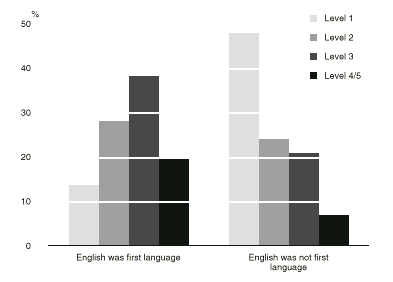
EDUCATIONAL ATTAINMENT
Educational attainment was another characteristic strongly linked to literacy performance. In general, greater proportions of people with high skill levels had high levels of educational attainment compared with those at lower skill levels. For example, 65% of people at Level 4/5 on the prose scale had a post-school qualification, compared with 22% of people at Level 1.
AGE
Younger people tended to have higher levels of literacy than older people.
Compared with older people, larger proportions of people aged under 45 had good skills (Level 4/5), with the exception of those aged 15-19. Many 15-19 year olds will not yet have completed their education and will have little work experience, and therefore their literacy skills may develop further.
The literacy skills of people aged 45 and over declined markedly with age. Some 41% to 46% of those aged 65-74 had very poor skills, and three-quarters were at Levels 1 and 2. This may be related to greater proportions of older people having lower educational attainment levels, and/or the relatively high rate of disabilities (some of which would affect literacy skills) among older people.
SEX
There were larger proportions of females at high levels of prose literacy for most age groups. However, in the 55-74 year age group, the proportion of males at Level 4/5 was greater than the proportion of females, possibly due to the (previous) better educational and labour force opportunities for males in this age group.
On the quantitative scale, the proportions of males with Level 4/5 skills were larger than the corresponding proportions of females across all age groups. In total, 22% of males were at Level 4/5, compared with 14% of females.
1.3 PROPORTION AT LEVEL 4/5, By Age - Prose Scale
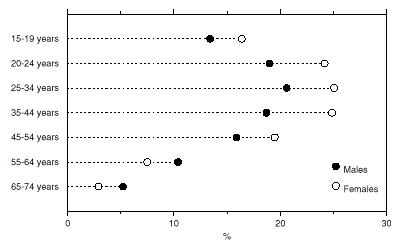 1.4 PROPORTION AT LEVEL 4/5, By Age - Quantitative Scale
1.4 PROPORTION AT LEVEL 4/5, By Age - Quantitative Scale
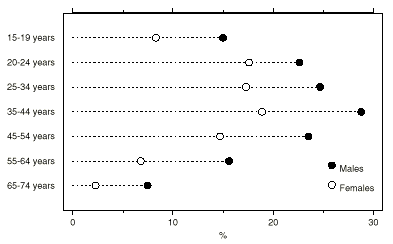
The proportion of older females at Level 1 on the quantitative scale was markedly greater than that of older males. For example, 45% of females aged 65-74 were at Level 1 compared with 37% of males.
On the document scale, the proportions of males and females with good skills (Level 4/5) were similar for those aged under 45, but older males tended to have better document skills than older females.
LABOUR FORCE STATUS
There was a clear relationship between literacy skill level and labour force status. Depending on the literacy scale, 11% to 12% of employed people were at Level 1. The corresponding percentages for unemployed people were 30% to 31%, and for those who were not in the labour force, the proportions were even larger.
The proportions at Level 2 within each labour force category were similar, but significantly larger proportions of employed people were at Levels 3 and 4/5, compared with unemployed people and those not in the labour force.
INCOME
Just 6% of people at Level 1 on the prose scale received an annual income in the highest quintile, compared with 30% of people at Level 4/5. Some 63% of people at Level 1 on the prose scale were in the two lowest income quintiles. The income distributions for Levels 2 and 3 were similar to the distribution for the total population.
The results on the document and quantitative scales were similar, but the proportion of people at Level 4/5 on the quantitative scale who were in the top income quintile was the highest of all scales, at 37%. This may be because greater proportions of males were at Level 4/5 on the quantitative scale compared with females, and males tend to have larger incomes.
INDIGENOUS PEOPLES
The SAL yielded some estimates for people who were of Aboriginal and Torres Strait Islander origin (Indigenous peoples). It should be noted that the exclusion of certain remote and sparsely settled areas from the SAL sample means that an estimated one-quarter of Indigenous peoples, who live in such areas, did not have a chance of being selected in the survey. As the English literacy skills of this group may differ from the skills of those Indigenous peoples living in urban areas, the following results should not be used as an indicator of the literacy skill levels of the total Indigenous population. Furthermore, because the number of people in the sample who identified themselves as Indigenous was small, the estimates produced have relatively high standard errors.
Of those Indigenous peoples represented by the sample, almost all (98%) reported speaking English as their first language.
Significantly greater proportions of Indigenous peoples were at low literacy levels compared with other people who spoke English as their first language, and their skills showed more variation across the three scales. Some 41% were at Level 1 on the prose scale, 45% were at Level 1 on the document scale, and 47% were at Level 1 on the quantitative scale.
Different levels of educational attainment may explain these results to some extent. Some 62% of Indigenous peoples did not complete the highest level of secondary school (the corresponding proportion for other people whose first language was English was 36%).1.5 PROPORTION OF INDIGENOUS PEOPLES AT EACH SKILL LEVEL
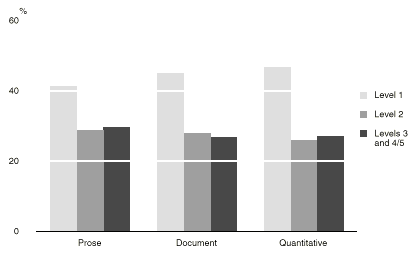
HOW DID THE OBJECTIVE ASSESSMENT COMPARE WITH PEOPLE'S SELF-PERCEPTIONS?
The objective assessment measured skills on the prose, document and quantitative scales after survey respondents had rated their own reading, writing and basic mathematical skills in the context of 'the needs of daily life'.
Self-rating of reading skills and objective assessment of prose skills
Almost all (92%) of those who rated their reading skills for the needs of daily life as poor were at the lowest level on the prose scale, with negligible proportions at each of the other levels.
Of those who rated their reading skills for the needs of daily life as excellent, 28% were at Levels 1 and 2 on the prose scale.
1.6 SELF-RATING OF READING SKILLS, By Prose Skill Level
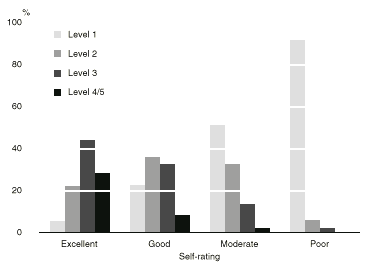
It may seem incongruous that some people who were objectively assessed as having relatively poor literacy skills rated their skills as excellent or good. One possible explanation for this is that people with lower skill levels (as measured by the objective assessment) who had little need to use advanced skills in daily life may consider that their skills are good enough to meet the demands placed on them, and, accordingly, rate their skills for the needs of daily life as good, or even excellent.
Self-rating of basic mathematical skills and objective assessment of quantitative skills
Of those who rated their basic mathematical skills for the needs of daily life as poor, 79% were at Level 1 on the quantitative scale, and 15% were at Level 2. This pattern suggests that the relationship between self-rating of basic mathematical skills and assessed quantitative skills is not as close as the relationship between self-rating of reading skills and assessed prose skills, where almost all of those who rated themselves as poor were at the lowest skill level.
Most of those who rated their basic mathematical skills as good had low to mid-range skills (Levels 1 to 3) but a significant proportion (12%) were at Level 4/5. Of those who rated their basic mathematical skills as excellent, 44% were at Level 3 and 33% were at Level 4/5, but significant proportions were at Levels 1 and 2 (23%).
1.7 SELF-RATING OF BASIC MATHS SKILLS, By Quantitative Skill Level
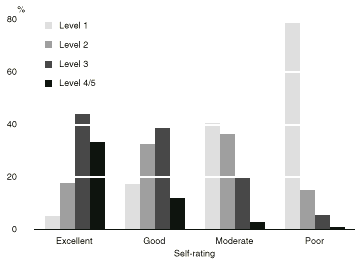
STATE OR TERRITORY OF USUAL RESIDENCE
New South Wales and Victoria had the largest proportions at Level 1 of all the States and Territories for each literacy scale, while the two Territories had the smallest proportions at Level 1. The SAL excluded people living in remote and sparsely settled parts of Australia and in the Northern Territory such regions account for over 20% of the population, as a result the Northern Territory estimates are not fully representative.
The Australian Capital Territory contained the largest proportion of people at Level 4/5 on each literacy scale. Tasmania and New South Wales had relatively small proportions at Level 4/5 on each scale.
Some of the differences between States and Territories in terms of literacy performance may be explained by differences in the socio-demographic characteristics of their populations.
LITERACY-RELATED ACTIVITIES IN DAILY LIFE
On each of the three scales, larger proportions of people at the higher skill levels undertook literacy-related activities at least once a week compared with those at lower skill levels.
1.8 PROPORTION UNDERTAKING ACTIVITIES AT LEAST WEEKLY - Prose Scale
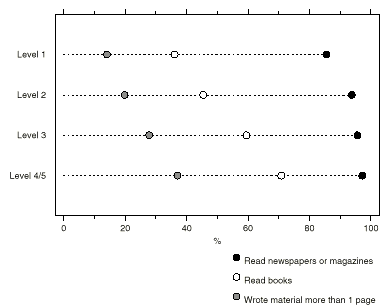 On all scales, very large proportions of people at Levels 2, 3 and 4/5 read newspapers or magazines at least weekly and these proportions increased slightly with skill level (approximately 93%, 96% and 97% respectively). However, the proportion at Level 1 who read newspapers or magazines at least weekly was smaller (about 85% on all scales).
The proportion of people who read books at least weekly increased as skill level increased. On the prose scale, 36% of people at Level 1 read books at least weekly, compared with 45% at Level 2, 60% at Level 3 and 71% at Level 4/5. Clearly, frequent reading of books was more closely related to prose skill level than was reading of newspapers or magazines.
The proportion of people at Level 1 who wrote material more than one page in length at least weekly was less than half the proportion at Level 4/5. On the prose scale, 14% of people at Level 1 wrote such material at least weekly compared with 37% at Level 4/5.
On all scales, the proportion of people at Level 4/5 who used a public library at least weekly was larger than the proportion at Level 1. However, a smaller proportion of people at Level 4/5 on the quantitative scale attended a public library, compared with those at Level 4/5 on the prose scale (12% compared with 16%). This emphasises that performance on one scale does not necessarily relate to performance on a different scale.
READING MATERIALS IN THE HOME
The proportions of people at Level 1 who had more than 25 books, a dictionary, or a daily newspaper in the home were markedly smaller than the corresponding proportions of people at higher skill levels. Having more than 25 books in the home appeared to be more closely related to performance on the prose scale than did having a dictionary or a daily newspaper. On the prose scale, 70% of people at Level 1 had more than 25 books in the home, compared with 85% at Level 2, 94% at Level 3 and 98% at Level 4/5.
1.9 PROPORTION WITH READING MATERIALS IN THE HOME - Prose Scale
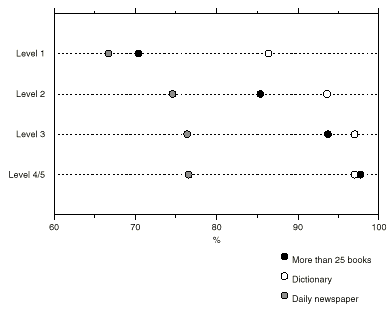
LITERACY-RELATED ACTIVITIES IN THE WORKPLACE
People who had worked in the 12 months before the survey were asked questions about literacy-related activities performed in their main job. Some 9,589,000 people aged 15-74 had worked in the 12 months before the survey.
A larger proportion of workers at Level 4/5 performed four or more reading activities at least weekly than did those at Level 1 (62% to 65% compared with 22% to 25% depending on the scale).
Similarly, depending on the scale, 52% to 55% of those at Level 4/5 performed two or more writing activities at least weekly, compared with 16% to 19% of workers at Level 1.
Prose literacy
The proportion of workers at each level on the prose scale who read or used letters or memos daily increased with higher skill levels. Of workers at Level 1, 31% read or used letters or memos daily, compared with 43% at Level 2, 53% at Level 3 and 63% at Level 4/5. Similarly, the proportion of workers who wrote letters or memos daily increased with skill level. However, at each skill level, smaller proportions wrote letters or memos daily compared with the proportion that read or used letters or memos daily.
The proportion of workers at each level on the prose scale who read or used reports, articles, magazines or journals daily also increased with higher skill levels. Of workers at Level 1, 14% read or used reports, articles, magazines or journals daily, compared with 35% at Level 4/5. However, the proportion of people at each level on the prose scale who wrote reports or articles daily increased less markedly with higher skill levels, rising from 9% at Level 1 to 14% at Level 4/5.
1.10 DAILY USE OF REPORTS, ARTICLES, MAGAZINES OR JOURNALS
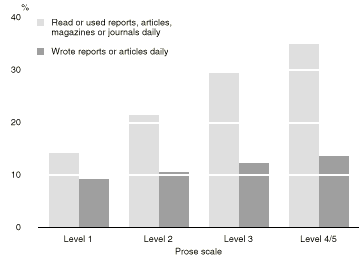 Document literacy
The proportion of workers who read or used bills, invoices, spreadsheets or budget tables daily increased with higher skill levels, rising from 14% at Level 1 to 32% at Level 4/5. However, the proportions who filled out forms such as bills, invoices or budgets daily were largest at Levels 2 and 3 (18% at both levels).
1.11 DAILY USE OF BILLS, INVOICES, SPREADSHEETS OR BUDGETS
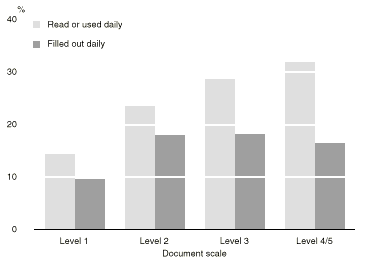
The proportion of workers who read or used diagrams or plans daily was largest at Levels 3 and 4/5 (20% and 21% respectively). However, for those who read or used diagrams or plans at least weekly, the difference between Level 3 and 4/5 was more marked: 41% of those at Level 3 read or used diagrams or plans at least weekly compared with 48% at Level 4/5.
Quantitative literacy
The proportion of workers at Level 1 on the quantitative scale who used arithmetic or mathematics at least weekly to measure or estimate the size or weight of objects was larger than the proportion that used arithmetic or mathematics at least weekly to calculate prices, costs or budgets (36% and 27% respectively). However, at Levels 3 and 4/5, larger proportions of workers used arithmetic or mathematics at least weekly to calculate prices, costs or budgets (51% at Level 3 and 53% at Level 4/5) than to measure or estimate the size or weight of objects (41% at Levels 3 and 4/5).
1.12 USED ARITHMETIC OR MATHS AT LEAST WEEKLY - Quantitative Scale
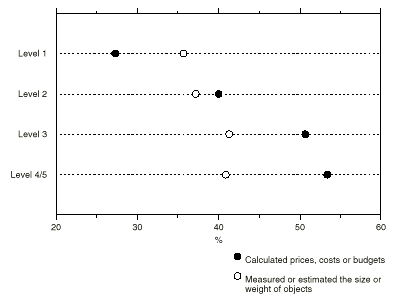
SOCIAL ACTIVITIES
People with high literacy skills had larger rates of participation in the following social activities nominated in the survey: attending a movie, play or concert; attending or taking part in a sporting event; and participating in volunteer or community organisations. On all scales, at Level 4/5, approximately 14% of people undertook two or more activities at least weekly, compared with 5% at Level 1.
On all scales, the proportions of people who did not undertake any of the activities at least weekly decreased as skill level increased: approximately 70% at Level 1 did not undertake any of the activities at least weekly, compared with about 53% at Level 2, 46% at Level 3 and 43% at Level 4/5.
NEEDING HELP WITH SELECTED LITERACY-RELATED ACTIVITIES
People were asked whether they needed help to undertake any of the following literacy-related activities in English: read information from government agencies, businesses and other institutions; read newspaper articles; read instructions such as on a medicine bottle; read instructions on packaged goods; write notes or letters; or fill out forms such as applications or bank deposit slips. They were also asked whether they needed help with basic arithmetic.
Compared to all other levels, much larger proportions of people at Level 1 (on each scale) reported needing help often with various activities. On all scales, approximately 7% of people at Level 1 reported needing help often with basic arithmetic, ranging up to 19% who reported needing help often to read information (in English) from government agencies, businesses or other institutions.
INTERNATIONAL COMPARISONS
Australia participated in the second round of the International Adult Literacy Survey (IALS) in 1996, along with New Zealand, the United Kingdom, and Belgium (Flemish-speaking). Pending the availability of results from these countries, the following table compares the skill level distributions for Australia with those of the other countries that participated in the first round of the IALS in 1994.
To enable valid comparisons across countries, the following table is restricted to people aged 16-65 and consequently the estimates in this table will differ from others in this publication.
|
 |
1.13 INTERNATIONAL COMPARISONS(a), People Aged 16-65
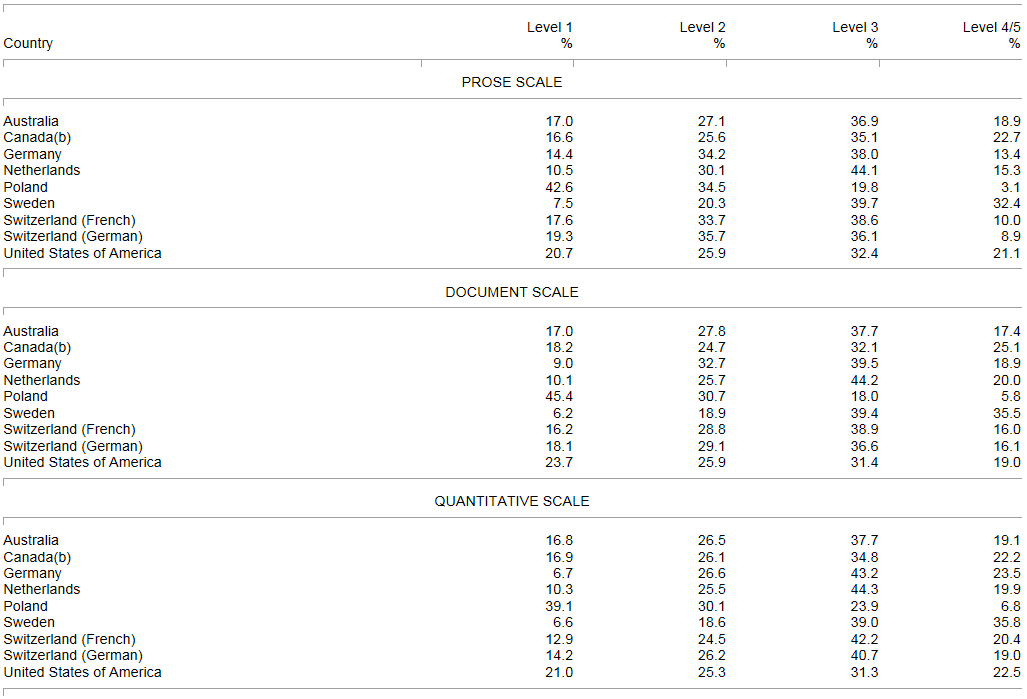
(a) Source: OECD 1995.
(b) Combined results for English and French languages. |
 Print Page
Print Page
 Print All
Print All